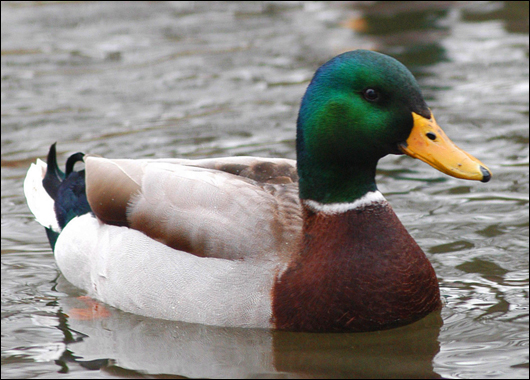
THE MALLARD DUCK
is the most common duck in North America and Northern Central America. The male mallards have grayish or brownish feathers, a green colored head, and a purple breast. The female is only brown and white and is smaller than the male. The normal mallard is 20 - 28 inches in length. Mallards molt in late spring or early summer, with the males molting earlier than the females. They nest under boulders, in tree holes, in the crotch of trees, or in open areas.Mallards are omnivores, eating various seeds including corn, wheat, barley, bulrushes, wild rice, primrose, willow, seeds of water elm, oak, hackberry, tree seedlings of swamps or river bottoms. They also eat mollusks, insects, small fish, tadpoles, freshwater snails, fish eggs, and frogs. They usually feed at the surface of the water and are known as "dabbling ducks". They don't dive all the way under the water, but just tip their heads under to feed.
To breed, the male attracts the female mate by ruffling his bright feathers. The pair usually does not stay together for long. The male mallard, or drake, leaves the female when she begins incubation and forms a group with other males. Nine to thirteen eggs are laid at daily intervals. Incubation begins when the clutch is complete and lasts for twenty seven to twenty eight days. The ducklings all hatch within 24 hours, mostly during the day. Once they are hatched, they are led to water. Mallards mature quickly and may breed less than 12 months of age. Although mallard ducks have been known to live as long as sixteen years of age, most of them only live for one or two years.
During the summer, mallards spend much time asleep on water banks. The mallard has only three defenses - swimming, flying, and camouflage, and it is prey to large mammals. Mallards have no defense against humans who are their biggest enemy. Many are killed by oil spills, pesticides and discarded fishing line.






